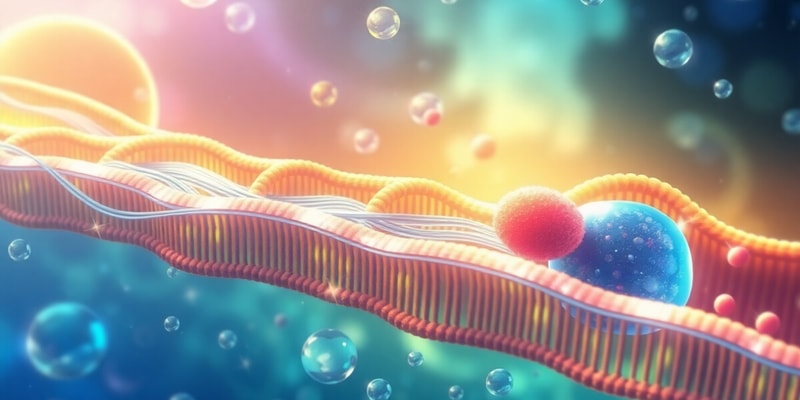Podcast
Questions and Answers
What is the primary function of the Na+ pump in the epithelial cells?
What is the primary function of the Na+ pump in the epithelial cells?
Which transporter is responsible for sodium-glucose co-transport in the intestinal lumen?
Which transporter is responsible for sodium-glucose co-transport in the intestinal lumen?
How does the Na+ pump influence osmosis in the interstitial space?
How does the Na+ pump influence osmosis in the interstitial space?
What role do tight junctions play in the absorption process of Na+ and glucose?
What role do tight junctions play in the absorption process of Na+ and glucose?
Signup and view all the answers
Which statement is true regarding the transport of Na+ across the epithelial cells?
Which statement is true regarding the transport of Na+ across the epithelial cells?
Signup and view all the answers
What role does AQP-1 play in the kidney collecting duct?
What role does AQP-1 play in the kidney collecting duct?
Signup and view all the answers
How is urine affected by the presence of ADH in the collecting duct?
How is urine affected by the presence of ADH in the collecting duct?
Signup and view all the answers
What is the impact of dehydration on the activity of ADH and AQP-2?
What is the impact of dehydration on the activity of ADH and AQP-2?
Signup and view all the answers
What happens to water reabsorption during diarrhea?
What happens to water reabsorption during diarrhea?
Signup and view all the answers
Why is simply providing Na+ and water ineffective for rehydrating a severely dehydrated individual?
Why is simply providing Na+ and water ineffective for rehydrating a severely dehydrated individual?
Signup and view all the answers
Which factor is essential for driving water reabsorption in the kidney collecting duct?
Which factor is essential for driving water reabsorption in the kidney collecting duct?
Signup and view all the answers
How does the Na+/Glucose cotransporter contribute to water uptake?
How does the Na+/Glucose cotransporter contribute to water uptake?
Signup and view all the answers
What is the main mechanism by which osmotic gradients drive water reabsorption in the kidney?
What is the main mechanism by which osmotic gradients drive water reabsorption in the kidney?
Signup and view all the answers
What must glucose do after absorption from the intestine?
What must glucose do after absorption from the intestine?
Signup and view all the answers
What characterizes epithelial cells in terms of their structure?
What characterizes epithelial cells in terms of their structure?
Signup and view all the answers
Why can't glucose enter epithelial cells by diffusion against its concentration gradient?
Why can't glucose enter epithelial cells by diffusion against its concentration gradient?
Signup and view all the answers
What is the role of tight junctions in epithelial cells?
What is the role of tight junctions in epithelial cells?
Signup and view all the answers
How does glucose move through the interstitial space?
How does glucose move through the interstitial space?
Signup and view all the answers
What happens when the membrane permeability (P) for glucose is zero?
What happens when the membrane permeability (P) for glucose is zero?
Signup and view all the answers
Which of the following statements is true about sodium ions (Na+) in relation to glucose absorption?
Which of the following statements is true about sodium ions (Na+) in relation to glucose absorption?
Signup and view all the answers
During the glucose absorption process, what characterizes the intestinal lumen in relation to glucose concentration?
During the glucose absorption process, what characterizes the intestinal lumen in relation to glucose concentration?
Signup and view all the answers
What type of transport occurs when glucose leaves the blood to enter muscle cells?
What type of transport occurs when glucose leaves the blood to enter muscle cells?
Signup and view all the answers
Which component primarily forms the structure of tight junctions in epithelial cells?
Which component primarily forms the structure of tight junctions in epithelial cells?
Signup and view all the answers
What is the primary mechanism for glucose absorption in the small intestine?
What is the primary mechanism for glucose absorption in the small intestine?
Signup and view all the answers
What is the role of tight junctions in the absorption of water in the gut?
What is the role of tight junctions in the absorption of water in the gut?
Signup and view all the answers
Under what condition is the bulk uptake of water a constitutive process?
Under what condition is the bulk uptake of water a constitutive process?
Signup and view all the answers
How does water generally flow in relation to its concentration gradient?
How does water generally flow in relation to its concentration gradient?
Signup and view all the answers
What best describes the absorption process of large volumes of water?
What best describes the absorption process of large volumes of water?
Signup and view all the answers
Which of the following best explains the concept of an osmotic gradient?
Which of the following best explains the concept of an osmotic gradient?
Signup and view all the answers
What physiological mechanism is involved in the bulk uptake of water in the kidneys?
What physiological mechanism is involved in the bulk uptake of water in the kidneys?
Signup and view all the answers
Which statement is true regarding the regulated uptake of water?
Which statement is true regarding the regulated uptake of water?
Signup and view all the answers
What is considered the biggest medical breakthrough of the 20th century in relation to fluid absorption?
What is considered the biggest medical breakthrough of the 20th century in relation to fluid absorption?
Signup and view all the answers
What is the primary function of the Na+/glucose co-transporter in the gut?
What is the primary function of the Na+/glucose co-transporter in the gut?
Signup and view all the answers
How does water primarily move from the lumen into the interstitial fluid in the gut?
How does water primarily move from the lumen into the interstitial fluid in the gut?
Signup and view all the answers
In the kidney collecting duct, what role do aquaporins play when ADH levels are high?
In the kidney collecting duct, what role do aquaporins play when ADH levels are high?
Signup and view all the answers
What occurs in the kidney collecting duct when ADH levels are low?
What occurs in the kidney collecting duct when ADH levels are low?
Signup and view all the answers
Which pathway allows for regulated absorption of water in the kidney?
Which pathway allows for regulated absorption of water in the kidney?
Signup and view all the answers
What is the osmolarity difference between the lumen and interstitial fluid that drives water movement?
What is the osmolarity difference between the lumen and interstitial fluid that drives water movement?
Signup and view all the answers
What is the primary difference between bulk absorption of water and regulated absorption?
What is the primary difference between bulk absorption of water and regulated absorption?
Signup and view all the answers
What physiological effect results from the action of Na+ and glucose in the osmotic gradient?
What physiological effect results from the action of Na+ and glucose in the osmotic gradient?
Signup and view all the answers
Which type of transport is primarily responsible for glucose entering the interstitial space from epithelial cells?
Which type of transport is primarily responsible for glucose entering the interstitial space from epithelial cells?
Signup and view all the answers
What is the significance of 'leaky' tight junctions in gut and kidney tubule function?
What is the significance of 'leaky' tight junctions in gut and kidney tubule function?
Signup and view all the answers
Study Notes
Transport Across the Cell Membrane
- Water will move across the cell membrane via a concentration gradient
- The concentration gradient of water is dictated by the concentration of solutes present
- Water will move from a region of high water concentration (low solute concentration) to an area of lower water concentration (high solute concentration)
- This is driven by osmosis.
- The difference in concentration across a membrane is referred to as the osmotic pressure.
Glucose Absorption
- Glucose is absorbed from the gut into the epithelial cells and then across the basolateral membrane into the interstitium
- It cannot move across the cell membrane against its concentration gradient
- This means glucose can enter the epithelial cell from the gut lumen via an active transport mechanism
- The concentration gradient of glucose is low in the gut lumen and high in the epithelial cell
- However, glucose can leave the epithelial cell across the basolateral membrane by moving down its concentration gradient
Sodium and Glucose
- Sodium can enter the epithelial cell from the gut lumen down its concentration gradient by moving through sodium channels
- This creates a concentration gradient of sodium across the cell membrane
- Movement of sodium across the cell membrane is an important physiological process
Sodium-Glucose Symporter
- The sodium-glucose symporter (SGLT) is a protein that is located in the apical membrane of epithelial cells in the gut
- It transports glucose into the epithelial cell against its concentration gradient by using the energy from the movement of sodium down its concentration gradient.
Water Absorption
- Water moves from the lumen of the gut to the interstitium via paracellular transport.
- Paracellular movement is the passage of substances between cells, as opposed to through cells.
- This process is known as bulk water absorption
- Bulk absorption of water from the gut occurs in the small intestine.
- This bulk movement of water is dependent on the osmotic gradient between the lumen of the gut and the interstitium
- In a healthy organism, water absorption from the gut is largely constitutive, meaning it occurs continuously
Water Reabsorption in Renal Tubules
- Water is also absorbed from the kidney tubules, as the body tries to retain water.
- The proximal tubule is where the majority of water re-absorption occurs.
- Water moves from the lumen of the renal tubule to the interstitium via paracellular transport, as with the small intestine
- The movement of water is driven by the osmotic gradient that exists between the lumen of the tubule and the interstitium
Aquaporins
- Aquaporins (AQPs) are specialized proteins that transport water across the cell membrane, using the transmembrane proteins to form a pore through which water moves.
- Aquaporins are found in a variety of cells in the body, which plays a crucial role in the regulation of water balance.
- The movement of water across the basolateral membrane of epithelial cells in the collecting duct is regulated by the presence of aquaporins.
- In the kidneys, aquaporins are responsible for the reabsorption of water from the urine, in a process known as ‘regulated water uptake’.
- The water movement in this process is regulated by the hormone Anti-diuretic Hormone (ADH).
Anti-diuretic Hormone (ADH)
- ADH is known as vasopressin, and it’s released by the posterior pituitary gland
- When the body is dehydrated, ADH levels increase.
- This causes AQP-2 to be inserted into the apical membrane of epithelial cells lining the collecting duct, allowing water to be reabsorbed into the body.
- ADH levels decrease when the body is hydrated, causing AQP-2 to be removed from the apical membrane, and water cannot be reabsorbed into the body.
- When AQP-2 is absent or present in small concentrations, urine is dilute and a large volume of water is lost
Oral Rehydration Therapy (ORT)
- Oral rehydration therapy is the use of oral fluids to treat dehydration, especially in cases of diarrhea
- It's the most efficient way to rehydrate a person who is suffering from dehydration
- The fluid given to the patient is usually a solution of electrolytes and glucose
- The glucose in the solution is essential for the absorption of sodium from the gut, which is crucial for the absorption of water
- This combination works because the sodium and glucose are absorbed together via the sodium-glucose cotransporter (SGLT), which is located in the apical membrane of epithelial cells in the gut.
Studying That Suits You
Use AI to generate personalized quizzes and flashcards to suit your learning preferences.
Related Documents
Description
Test your understanding of how water and glucose are transported across the cell membrane. This quiz covers concepts such as osmosis, concentration gradients, and active transport mechanisms. Perfect for students studying cell biology and physiology.




